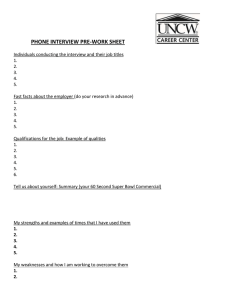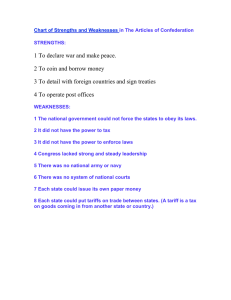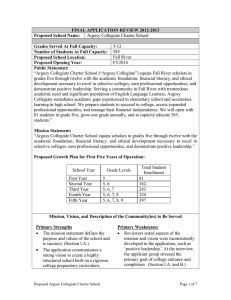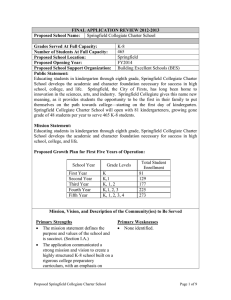item2 ccs apprev
advertisement
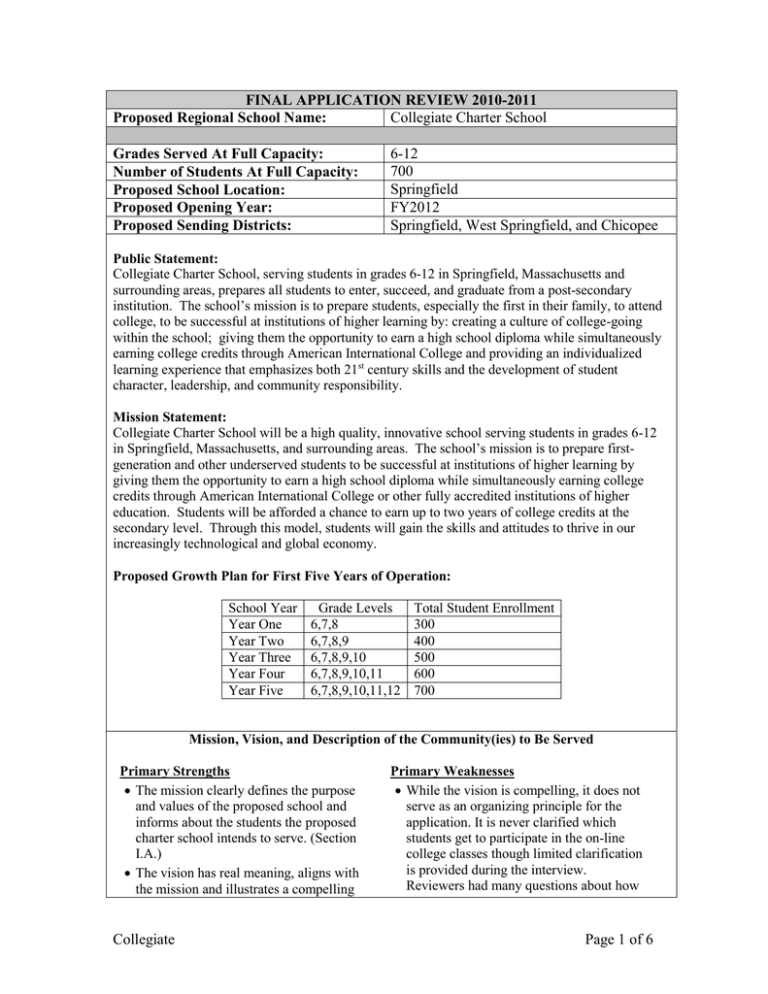
FINAL APPLICATION REVIEW 2010-2011 Collegiate Charter School Proposed Regional School Name: Grades Served At Full Capacity: Number of Students At Full Capacity: Proposed School Location: Proposed Opening Year: Proposed Sending Districts: 6-12 700 Springfield FY2012 Springfield, West Springfield, and Chicopee Public Statement: Collegiate Charter School, serving students in grades 6-12 in Springfield, Massachusetts and surrounding areas, prepares all students to enter, succeed, and graduate from a post-secondary institution. The school’s mission is to prepare students, especially the first in their family, to attend college, to be successful at institutions of higher learning by: creating a culture of college-going within the school; giving them the opportunity to earn a high school diploma while simultaneously earning college credits through American International College and providing an individualized learning experience that emphasizes both 21st century skills and the development of student character, leadership, and community responsibility. Mission Statement: Collegiate Charter School will be a high quality, innovative school serving students in grades 6-12 in Springfield, Massachusetts, and surrounding areas. The school’s mission is to prepare firstgeneration and other underserved students to be successful at institutions of higher learning by giving them the opportunity to earn a high school diploma while simultaneously earning college credits through American International College or other fully accredited institutions of higher education. Students will be afforded a chance to earn up to two years of college credits at the secondary level. Through this model, students will gain the skills and attitudes to thrive in our increasingly technological and global economy. Proposed Growth Plan for First Five Years of Operation: School Year Year One Year Two Year Three Year Four Year Five Grade Levels 6,7,8 6,7,8,9 6,7,8,9,10 6,7,8,9,10,11 6,7,8,9,10,11,12 Total Student Enrollment 300 400 500 600 700 Mission, Vision, and Description of the Community(ies) to Be Served Primary Strengths The mission clearly defines the purpose and values of the proposed school and informs about the students the proposed charter school intends to serve. (Section I.A.) The vision has real meaning, aligns with the mission and illustrates a compelling Collegiate Primary Weaknesses While the vision is compelling, it does not serve as an organizing principle for the application. It is never clarified which students get to participate in the on-line college classes though limited clarification is provided during the interview. Reviewers had many questions about how Page 1 of 6 image of the school’s future. (Section I.B.) The description of the communities to be served speaks to the value of the proposed school. The section briefly explains that college attendance rates in these communities are low and that many of these students come from impoverished homes. This proposed school could provide students with this unique opportunity, an immediate head start in the acquisition of college credits at no cost. It states that the school is committed to educating all learners and provides limited information regarding the needs of students who require special education and English language learners and asserts the founder’s abilities to serve these populations. (Section I.C.) Senator S. Buoniconti and Congressmen R. Neal voiced their support for this charter application within the application. (Section I. C.) the comprehensive support structure to ensure academic and social skills necessary for college access and success will operate. (Section I.A.) Within the application and during the interview, limited information is provided about the middle school students in these communities and the needs of these students. (Section I.C.) Educational Philosophy, Curriculum and Instruction Primary Strengths The application explains seven key practices that the proposed school will utilize. In the interview the founding group discussed the necessary mechanisms to make every student high achieving, such as extended day, family engagement, service learning, and community involvement. The group also explained that they have a student-centered philosophy. (Section II.A.) The application stated clear non-academic goals and multiple measures to assess student performance regarding these goals. The goals described are multicultural and multiethnic diversity, community collaboration, and wellness which are not explicitly aligned with the school’s mission. (Section II.B.) The application describes frequent opportunities for faculty to participate in professional development during the summer and the school year. The Collegiate Primary Weaknesses The educational philosophy explains key practices at the school; however, it is not integrated into the implementation of a comprehensive educational program. For example - tailored studies is critical to the educational philosophy of the school, the application describes how all students will have an Individualized Educational Plan (IEP), Students Goals Plan (SGP), Learning Profiles, and personal portfolios, it is never clear how this complex system will be implemented and managed. (Section I.A.). The curriculum and instruction section lacks information about the dual enrollment aspect of the school. (Section II.B.) While a curriculum committee is mentioned, the plan lacks on-going curricular components that will facilitate the ongoing evaluation, development, implementation, improvement, and Page 2 of 6 application names instructional values that the applicant group has identified as components of effective teaching. (Section II.B.) refinement of curriculum. (Section II.B.) While the instructional methods described are multifaceted, inquiry-based learning, project based learning, mentored study, technology-based learning and communitycentered learning, with internships and jobshadowing, it is not clear either in the application or during the interview how these components will be developed, structured, and operationalized to function. (Section II.A, II.B. and II.E.) Assessment System, Performance, Promotion, and Graduation Standards Primary Strengths While it’s not clear how all the data will be collected, analyzed, and managed, the Assessment System features multiple measures of student outcomes and describes the use and reporting of data to multiple stakeholders. (Section II.D.) Primary Weaknesses While grade promotion and graduation standards for the most part are straightforward, no examples of performance standards are given in the application. (Section II.C.) Reviewers were concerned that the promotion standards were not rigorous (must fail three core subject courses to be retained). (Section II.C.) It is not clear how the early college aspect of the mission and vision are integrated into the assessment system or graduation requirements. (Section II.C. and II.D.) School Characteristics Primary Strengths Although there are questions about how the family resource center operates, the application outlines plans to build and maintain family-school partnerships. (Section II.E.) The application describes a behavior philosophy that is aligned with the proposed school’s core beliefs. The application also includes a Student Code of Conduct that details student’s rights and responsibilities as well as discipline procedures. (Section II.E.) Collegiate Primary Weaknesses Reviewers had many questions about the characteristics of the school, including but not limited to questions about: o scheduling; o the college experience provided through on-line college courses; o the summer transitional academy; o middle verses high school expectations and culture; o prep periods for teachers; o achievement center and enrichment operations and staffing; o community services, internships, job- Page 3 of 6 shadowing, and mentoring programs; and o the proposed relationships with American International College and Futures Education. Reviewers were concerned about the lack of a blueprint for the effective implementation, management, and evaluation of such varied programming within a school day. (Section II.E.) Special Student Population and Student Services Primary Strengths Within the application and during the interview, the applicant group indicated the use of the Response to Intervention model to provide a responsive general education classroom for all learners. (Section II.F.) The application and the applicant group reported that all teachers will be trained in Sheltered Instruction Observation Protocol (SIOP). During the interview, the applicant explained their commitment to provide Sheltered English Immersion (SEI) category training for faculty. (Section II.F.) The application states that general teachers will adapt curriculum to increase comprehension and access for Limited English Proficient (LEP) students, and the school will employ a part-time ESL specialist to work with LEP students as necessary in pullout environments as well as in their academic core classes. (Section II.F.) Primary Weaknesses The description of the processes and procedures used to identify, assess, and serve English language learners had some missing pieces or inaccurate components. For example, the section does not use the term “home language survey”, nor does it mention the Language Assessment Survey (LAS). (Section II.F.) While the application proposes reasonable staffing levels for the anticipated student populations, the application does not provide an adequate description of the processes and procedures used to identify, assess, and provide specialized instruction to students in need of special education. (Section II.F.) Enrollment and Recruitment Primary Strengths No primary strengths. Collegiate Primary Weaknesses The section on enrollment and the draft enrollment policy provides limited information. (Section III.A.) The draft enrollment policy is not in accordance with charter school statute and regulations. (Section III.A.) Page 4 of 6 Capacity and School Governance Primary Strengths The founding group and proposed board of trustees include an impressive list of educational leaders who have strong and tangible ties to the communities the school intends to serve. (Section III.B.) The proposed board of trustees has experience in higher education, law, notfor-profit management, public education, and serving students with special needs. (Section III.B.) The application presented a clear process for board policy development and decision making, and recruiting, selecting, and developing board members. (Section III.C.) Primary Weaknesses Reviewers had concerns about some of the conflicts of interest on the proposed board of trustees; this was discussed at the interview. After the interview, the applicant group checked with the State Ethics Commission and reported to the Department that they would need to make changes in the proposed board of trustees. Without knowing who is on the proposed board of trustees at this time it would be difficult to determine capacity of the proposed board of trustees. (Section II.C.) Management Primary Strengths While there are questions about some of the job descriptions provided in the attachments, the application provided information about the roles and responsibilities of key positions. (Section III.D.) Primary Weaknesses While the application proposes significant contractual relationships with both American International College and Futures Education, the roles and responsibilities of these entities are never fully articulated. Furthermore, it is not clear how the proposed board will monitor and evaluate these services. (Section III.C.) In the application, Dr. Suzanne Marotta is described as the proposed Executive Director. During the interview, the applicant group stated that they will be performing a candidate search for the proposed Executive Director position. (Section III.B and Section III.C.) Facilities, Transportation, and Finances Primary Strengths No primary strengths. Collegiate Primary Weaknesses The section on school finances does not include any information about fiscal controls and financial management policies. (Section III.F.) Reviewers had many questions about the budget. The interview provided some clarifications; however questions remain, and the assumptions did not always correspond with the budget. (Section III.F.) Page 5 of 6 The applicant group proposes to contract with American International College and Futures Education for fees of $389K and $668K respectively during the first operational year. The application does not contain a contract with either organization and during the interview the applicant group could not clearly explain how the fees and need for services were determined. (Section III.F.) Collegiate Page 6 of 6

